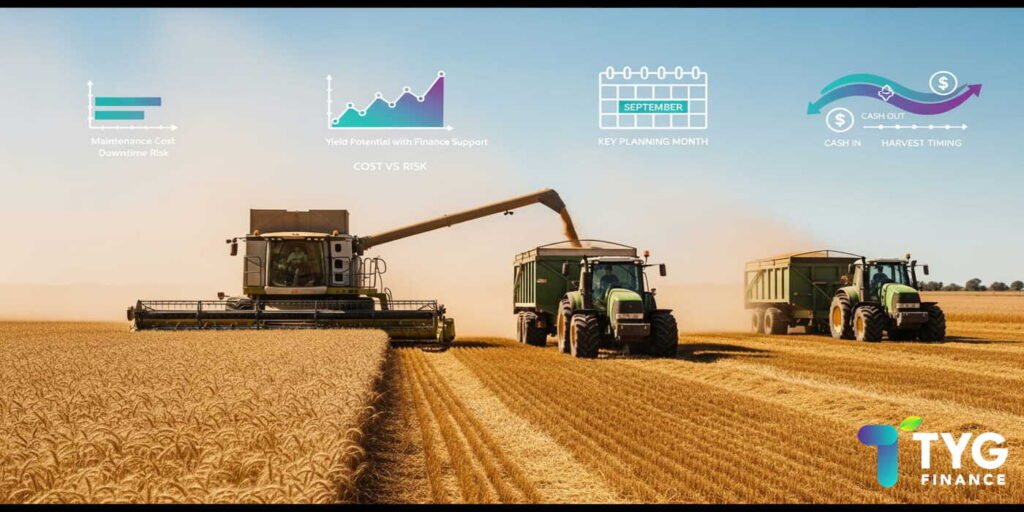The Countdown to Harvest
For agricultural operators, September is the start of the sprint. Tractors, headers, chaser bins, and grain trailers must perform at peak efficiency inside narrow weather windows. When crops are ripe, every hour counts; delays mean yield loss, quality downgrades, and lost revenue.
This guide sets out a practical harvest-prep sequence — maintenance, utilisation analysis, logistics capacity — and shows how season-aware financing helps operators maximise uptime without over-stretching cash.
Step 1: Lock In Uptime With Pre-Harvest Maintenance
- Headers/combines: Inspect cutter bars, concaves, sieves; calibrate sensors; service engines and hydraulics; test grain-loss monitors.
- Tractors: Check cooling systems for spring heat, replace perished hoses, update ECU software, verify PTO performance.
- Augers & conveyors: Inspect bearings, belts, chain drives; test guarding and emergency stops.
- Trailers: Check braking systems, tyres, lights, and grain-door seals to prevent spillage and delays.
Proactive maintenance is cheaper than the combination of breakdown + crew idle time + weather risk.
Step 2: Use Utilisation Data to Target Investment
Review last season’s hours, fuel burn, and repair spend. Ask:
- Which machines consistently ran at or above forecast hours?
- Did repair and downtime costs on one unit exceed the finance cost of a newer model?
- Which assets sat idle and could be sold to fund upgrades?
Telematics makes these answers clearer — turning gut feel into evidence-based planning.
Step 3: Finance Designed for Agriculture
Generic loans often clash with farm cash flow. Agricultural machinery finance is built for seasonality:
- Repayment timing: Heavier after delivery/receival; lighter during planting or low-income months.
- Balloon/residual options: Tailored to expected resale values or upgrade cycles.
- Pre-approval buffers: Act fast when a well-priced machine appears or a contractor slot opens.
Explore Agricultural Machinery Finance structured for harvest realities.
Step 4: Don’t Forget the Logistics Chain
Harvest doesn’t end at the header. Grain must move — on-farm to receival, or farm to port.
- Prime movers + dollies sized for farm access and axle groups.
- Tippers/field bins aligned to header output to avoid choke points.
- Weighing & moisture testing gear to streamline receival.
Balance capacity with Trailer Finance where extra haulage is the constraint.
Two Additional Harvest Bottlenecks (and Fixes)
- Choke points at field edges. If headers outrun haulage, add field bins or a second truck to avoid idle headers waiting for empties.
- Moisture management delays. Portable moisture meters and clear reject-process workflows save hours at receival.
Contractor vs Ownership: A Balanced View
Hiring a contractor can plug shortfalls but can be constrained during peak weeks. Financing a backup unit offers control and certainty; a blend — own the critical path, hire the rest — often works best.
Harvest Prep FAQ
What if yields disappoint?
Season-aware facilities can taper repayments in lean years; consider terms before you sign.
What if weather pushes harvest later?
Plan commissioning buffers and ensure transport capacity can flex when windows move.
How do I avoid crew fatigue?
Design shift rotations now, pre-position spares, and brief teams on “stop for ten” rules when faults emerge.
Deep Dive: Matching Capacity Across the Harvest Chain
A harvest runs only as fast as its slowest link. Consider end-to-end:
- In-paddock throughput: Header capacity (tonnes/hour) × operating hours per day.
- Field extraction: Chaser bin size and cycle time; turning radii around headlands; soil compaction risk.
- On-farm transfer: Auger capacity, elevation angles, safe guarding for night operations.
- Road haulage: Trailer cubic and mass limits, axle groupings, queue times at receival.
- Receival scheduling: Booking windows, moisture/contamination standards, contingency plans for rejections.
When one link can’t keep up, the whole chain slows. Financing the right link — sometimes a second truck, sometimes a larger chaser bin — often yields the biggest ROI.
Template: 7-Day Pre-Harvest Readiness Sprint
- Day 1: Confirm labour rosters, licences, inductions; test radios and lighting kits.
- Day 2: Final header inspection; carry belts, bearings, and knife sections.
- Day 3: Trailer brakes/tyres/lights; check grain door seals; calibrate scales.
- Day 4: On-farm fuel and DEF levels; spill kits positioned; fire extinguishers serviced.
- Day 5: Moisture meters calibrated; sample workflow agreed; receival documents pre-filled.
- Day 6: Route checks for height/bridge limits; detours mapped; heat policy briefed.
- Day 7: Dry run: 2-hour simulation from cut to cart to receival — log bottlenecks and fix.
Example: A Mixed-Crop Farm in NSW
Last year a grower lost two days when a worn bearing failed on a header. This spring they pulled forward servicing, financed a near-new backup header, and added two tipper trailers via seasonal facilities. With repayments aligned to grain delivery, they protected cash flow and captured the narrow harvest window.
Step 5: Market and Regulatory Context
The Department of Agriculture seasonal outlooks show variable conditions by region. Some growers will face bumper logistics challenges; others may need flexibility if rain shifts timing. Season-aware facilities help both groups manage risk.
Step 6: Harvest-Ready Checklist
| Area | Risk if Ignored | September Action |
|---|---|---|
| Header/Combine | Grain loss, fires, stoppages | Full inspection; calibrate sensors; carry spares |
| Tractors | Overheating under load | Flush coolant; test PTO; replace hoses |
| Trailers | Brake failures, delays | Inspect brakes/tyres/lights; verify seals |
| Labour | Bottlenecks, fatigue | Confirm rosters; train casuals; plan breaks |
| Finance | Procurement delays | Pre-approvals; align repayments to receivals |
Conclusion: Preparation Pays at Harvest
In agriculture, timing is everything. Maintenance, utilisation analysis, and logistics planning reduce risk; season-aware finance turns those plans into action without straining working capital.
Begin your finance journey with TYG Finance and ensure your machinery is harvest-ready.


